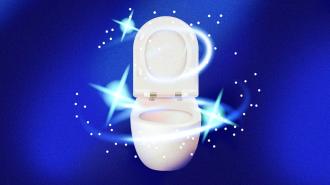A new slippery toilet bowl could free us from the hassle of scrubbing away stains, saving both time and water.
The challenge: About 30% of the water used in residential homes goes straight down the toilet, literally. Each time you flush away your waste, you’re sending up to six gallons of water into the sewer and on to a wastewater treatment plant.
The more water we need to flush to get our waste out of our bathrooms and to treatment facilities, the more dirty water we need to treat and the more clean water we need to create — and both processes require electricity that usually comes from the burning of fossil fuels.
The slippery toilet bowl: Researchers at Huazhong University of Science and Technology (HUST) in China have come up with an innovative way to slash the amount of water needed per flush: slippery toilet bowls.
“The reduced flushing volume would result in less wasted water.”
Yike Li
While researchers have developed Teflon-like coatings for toilet bowls in the past, those needed to be reapplied after so many flushes — the HUST team’s tech is built into the toilet bowl, making it a more durable option.
Because whatever goes into the slippery toilet bowl slides right down to the bottom, we could dramatically decrease the amount of water needed per flush. As an added bonus, the bowl never gets stained.
How it works: To build what they’re calling the “Abrasion-Resistant Super-Slippery Flush Toilet” (ARSSFT), the HUST team first created a mixture out of plastic and hydrophobic sand grains, which repel water.
Using this mixture and selective laser sintering — a 3D-printing technique that uses lasers to bind powders into solid shapes — they created a mini toilet bowl with a porous structure. They then lubricated its surface with a silicon oil, which sank deep into the model thanks to the pores.
The researchers then threw everything they could into the slippery toilet bowl — milk, muddy water, dyed honey, yogurt, fake feces, etc. — and watched as it slid right down to the bottom. The bowl was just as slippery even after they rubbed it with sandpaper and scored it with a utility knife, too.

Looking ahead: Selective laser sintering isn’t typically used to make large products, and the cost of 3D-printing a full-sized toilet bowl using HUST’s technique would be significantly greater than current manufacturing processes, but that doesn’t mean mass producing ARSSFT bowls would be impossible.
William Wong, a research fellow in the applied physics department at Aalto University, who wasn’t involved in this study, told New Scientist he thinks a startup could potentially figure out a way to incorporate the technique into the manufacturing process, as those companies “often [tend] to have flexibility in redesigning their supply chains.”
Even if the cost couldn’t be brought down enough to make sense for residential use, developer Yike Li told New Scientist he believes installing his team’s slippery toilet bowls in trains, public restrooms, and other high-volume settings could prove worthwhile.
“The reduced flushing volume would result in less wasted water during transportation to the processing facilities, thereby saving transportation costs,” said Li.
We’d love to hear from you! If you have a comment about this article or if you have a tip for a future Freethink story, please email us at [email protected].






